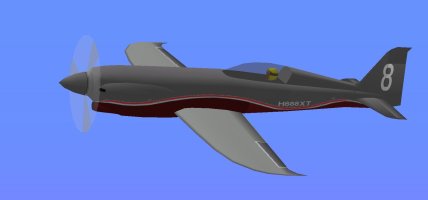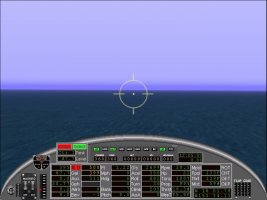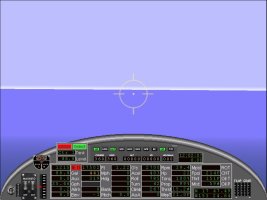Hello Aleatorylamp,
Anna Honey got back from her trip yesterday. I think it burned her out because she is still sleeping and almost never sleeps this late.
I just had a little snack / breakfast and thought I would check in and see any developments.
Turns out I need to apologize. The graph you are using also has the needed slopes, it is just not so obvious because of the scaling. I rescaled your screenshot and can see it better now. I still think the graph is wrong for the coarser pitch angles and this graph explains why your NXT blasts through those angles so fast.
Beckwith's tutorial on propellers which is where I started has a Power Coefficient graph similar to yours. It took me quite some time to realise that the majority of the useful information was being hidden by the scale of the images. I re-scaled your screenshot image and perhaps now you can see that it really isn't anywhere close to horizontal lines for the finer pitch angles if graphed to a useful scale.
As for the Power Coefficient for the Airacobra that I posted here, you are STILL not paying attention to what I am pointing out.
The Horizontal Red Dashed line is NOT at Zero. It is at 0.178. If you look closely, you will see that the 27 Degree pitch angle series also starts at the same place. (I wonder why?)
The second attachment shows a calculated Power Coefficient versus Altitude table for the Airacobra that should explain why I chose to use 0.178 as the Dashed Line to see how the Propeller would behave.
Basically, this is what would happen to the propeller as the Airacobra goes from Zero airspeed to its Maximum Level Speed which is achieved at 12,500 Feet.
I suggest you build such a table for your NXT. I don't think you need to go to 40,000 Feet. Heck, the Airacobra really can't get there either but it was worth seeing what would happen to power as altitude increased.
The Airacobra was known as a low / medium altitude fighter with an inadequate supercharger and I tried to tune it to behave that way which is why it hits maximum power at 12,500 Feet. As you can see from the Horsepower versus Altitude table, it drops off power pretty quickly as it gains altitude. It would not have been difficult to tune it for a couple thousand feet higher which is what you are trying to do with your NXT.
I believe you are doing something strange which I can't figure out from here. AirWrench in CFS2 probably did a more reasonable engine build which is why it got a more consistent power curve.
Enough for now. I have chores to do.
- Ivan.
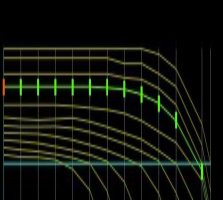
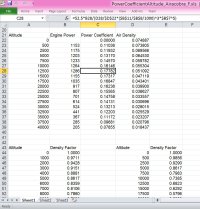
Anna Honey got back from her trip yesterday. I think it burned her out because she is still sleeping and almost never sleeps this late.
I just had a little snack / breakfast and thought I would check in and see any developments.
Turns out I need to apologize. The graph you are using also has the needed slopes, it is just not so obvious because of the scaling. I rescaled your screenshot and can see it better now. I still think the graph is wrong for the coarser pitch angles and this graph explains why your NXT blasts through those angles so fast.
Beckwith's tutorial on propellers which is where I started has a Power Coefficient graph similar to yours. It took me quite some time to realise that the majority of the useful information was being hidden by the scale of the images. I re-scaled your screenshot image and perhaps now you can see that it really isn't anywhere close to horizontal lines for the finer pitch angles if graphed to a useful scale.
As for the Power Coefficient for the Airacobra that I posted here, you are STILL not paying attention to what I am pointing out.
The Horizontal Red Dashed line is NOT at Zero. It is at 0.178. If you look closely, you will see that the 27 Degree pitch angle series also starts at the same place. (I wonder why?)
The second attachment shows a calculated Power Coefficient versus Altitude table for the Airacobra that should explain why I chose to use 0.178 as the Dashed Line to see how the Propeller would behave.
Basically, this is what would happen to the propeller as the Airacobra goes from Zero airspeed to its Maximum Level Speed which is achieved at 12,500 Feet.
I suggest you build such a table for your NXT. I don't think you need to go to 40,000 Feet. Heck, the Airacobra really can't get there either but it was worth seeing what would happen to power as altitude increased.
The Airacobra was known as a low / medium altitude fighter with an inadequate supercharger and I tried to tune it to behave that way which is why it hits maximum power at 12,500 Feet. As you can see from the Horsepower versus Altitude table, it drops off power pretty quickly as it gains altitude. It would not have been difficult to tune it for a couple thousand feet higher which is what you are trying to do with your NXT.
I believe you are doing something strange which I can't figure out from here. AirWrench in CFS2 probably did a more reasonable engine build which is why it got a more consistent power curve.
Enough for now. I have chores to do.
- Ivan.



